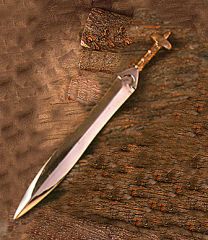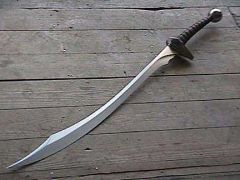-
Posts
13 -
Joined
-
Last visited
Content Type
Profiles
Forums
Articles
Gallery
Downloads
Events
Everything posted by KnarfleTheGarthock
-

Case Hardening and alloying
KnarfleTheGarthock replied to KnarfleTheGarthock's topic in Swordsmithing
Thanks everyone I just wish I knew how to delete an old thread. This one keeps getting new posts and it does not need it. If there is a forum moderator it is fine to remove this now. THANKS ALL. -

Case Hardening and alloying
KnarfleTheGarthock replied to KnarfleTheGarthock's topic in Swordsmithing
Right, wow. I did not expect such a psychological profiling of my posting. My identity is my own, but this handle is used as my "main" handle and so therefore I do not wish to give away any information I don't have to. I came here because I had an idea. That is what I do. I think. I know that might seem a little odd but that is my thing. I am not a child or a minor. I simply try to break away from conventional thinking as often as possible. It is a well known fact that most discoveries are made by the people who are working on the fringe of accepted practices. You can keep on making wheels till the cows come home, but something different happens if you put a wheel in a river or use it to wrap coated copper wire and then introduce and electrical or magnetic field. So reinventing the wheel might not be such a bad idea after all if you think about it. Most of my work is theoretical and it is not often that I get the chance to see the results or do the fine tuning myself. In this I envy anyone who is capable of working with their hands. It is a gift I do not possess. Unfortunately my lack of experience in this field has left me bereft of the proper language in order to make myself clear. The idea was not to make a uniformed material, but rather to make a layered material that would benefit from the properties of other elements. In this way i was hoping to keep the flexibility of steel, with the hardness of carbon etc. There were other considerations as well such as magnetic properties but I did not think that this would be the proper forum in which to discuss them. My real intent was to ascertain the plausibility of the manufacture process. Is it possible to add material with a dissimilar melting point then steel with an uneven distribution (in layers) of lets say platinum without heating the steel to molten. See if you just add all of the elements together you get an even mixture but the properties of the blade can be altered according to the method of fabrication. This is demonstrated in the method of fabrication for forming a Japanese sword. Think of sandpaper. There is the backing which is the paper and there is the grit. Now with sandpaper you use glue to hold it all together. Metal does not work so simply I am afraid. Thus the ill worded posts earlier. In any event an alternative solution to the problem was discovered and thus this thread need not be expanded upon. I hope that this exceeds your expectations in explanation. Thank you for your time and consideration. KnarfleTheGarthock -

Case Hardening and alloying
KnarfleTheGarthock replied to KnarfleTheGarthock's topic in Swordsmithing
Again thanx you, I am already collecting the suggested reading material and will endeavour to learn more about this fascinating subject. My original question was part of a research project, but now that I have started learning I am finding it hard not to want to learn more. This is so fascinating, there are so many variables to understand and try to control, so many new skills to learn. It will take time. The first step will be reading the material you guys suggested. As for my personal information, you will just have to learn to accept that I will not, at any cost reveal more, than is absolutely necessary about myself. Please try not to take offence it has absolutely nothing to do with my estimation of your personal honour. Also I would ask as a personal favour that the subject of my identity be left alone completely. I will not respond to any further questions about this. As for the name I chose: To Knarfle The Garthock; A form of punishment on the planet Remulak. The offending conehead is placed in a Coliseum-like arena containing thousands of spectators. When the garthock is released the prisoner must battle it using only a hook and short staff. If the garthock is successfully Knarfled (killed), the prisoner regains his honour. If he fails the conehead is killed and eaten by the garthok. You have betrayed your cone heritage; therefore, you will . . . knarfle the garthok! It is an expression that was made popular by the movie coneheads and refers to accomplishing something impossible. I know it is a little more obscure than the Conan reference that is my sig. but still, thought did go into the choice. I realise that everyone here uses their name and if my pride was the only thing at stake I would do so as well. I am hoping that this will not preclude me from your company, but if that is the case than so be it. I don -

Case Hardening and alloying
KnarfleTheGarthock replied to KnarfleTheGarthock's topic in Swordsmithing
Just a question do you ever feel the need to experiment with materials that you made yourself? It think it would be cool to try and smelt some ore myself! Perhaps alloy that and turn it ito a beautiful thing of form and function. Something that will be apreciated as a thing of beauty that others would enjoy. Whoever gets to do this porfessionally is a lucky person I think. It is almost like making jewllery. But thats just my opinion. -

Case Hardening and alloying
KnarfleTheGarthock replied to KnarfleTheGarthock's topic in Swordsmithing
I want to thank everyone for their advice I have a great deal to learn, I know some, but could afford to learn much more. I am very excited about the thought of exploring this wonderful craft with you. I wonder how long it will take to read all those books? Thanks for the titles I will go look them up Thank you. :) -

Case Hardening and alloying
KnarfleTheGarthock replied to KnarfleTheGarthock's topic in Swordsmithing
JPH.... Thank you so much, I really appreciate your candour and detail. Thank you for providing suitable alternative systems of modern bladesmithing. I will be sure to include them as valuable data. As I said in the beginning I am asking about things I was told by someone else. Having someone say not only that it is silly but also providing me with an explanation as to why and adding comments on the correct method of modern sword making; make your post the most valuable in the room so far. Thank you, you have saved me hours of reading and provided useful answers to the question I was asking, both quickly and efficiently. You sir are a pillar of respectability. I cannot express to you enough, how nice it is to get a straight answer. :) -

Case Hardening and alloying
KnarfleTheGarthock replied to KnarfleTheGarthock's topic in Swordsmithing
ok thank you, i will go study the stuff you guys suggested. Thanks for the advice and pointing me in the right direction. I really apreaciate it. -

Case Hardening and alloying
KnarfleTheGarthock replied to KnarfleTheGarthock's topic in Swordsmithing
It is not that I am ashamed of myself or my lack of knowledge. :mad: All I am doing is asking a bunch of more experienced people to give me their opinion on things that I have heard and that sound interesting. As for why I don’t give out my personal information, well if you don’t understand the need for internet security I guess your ignorance shouldn't bother me. After all, I am ignorant about many aspects of blacksmithing and ask for your patience don’t I? You can go to http://www.btplc.com/onlineidtheft/onlineidtheft.pdf to read more information However I will ask that if you don’t have anything useful to add or if you are feeling particularly bullish and want to write an angry or vicious statement in the future. Well I would just ask that you control yourself better. Thank you for your self restraint to those who have it and to everyone who has tried to answer my questions for me. The information is useful to me and I appreciate you taking the time to answer. As to my reasons for wanting to use titanium and platinum... I am looking for some of the color and texture that comes from using these metals together. I was also hoping to impart some of the corrosion resistance of the platinum without losing strength and flexibility that makes a sword a good weapon. Obviously the melting temp of either platinum or titanium are far to high to add iron or steel when they are at the melting point. The iron or steel would just burn off right? So I am investigating alternative methods. Also I was under the impression that titanium was harder than a soft steel or iron. I am still learning. Is it the other way around? I know that I must read more. What i am really looking for is a bunch of layers that are bonded together of soft hard and pretty. I want my cake and want to eat it too I guess. Case hardening as I make each of the folds would allow layers of 10-20 thousanths of a inch thick of higher carbon right? That is what you guys are saying. I know I am going to be fooling around with the temper as I do this. I also know that it will take a long time and lots of stages and folds to get what i am thinking of, but it might work out in the end. Or am I just wasting time even trying? Apparently there is a seamless welding method that uses weight and a spinning motion to mix two dissimilar metals at low temperatures. Unfortunately it takes a huge expensive unavailable machine to do it and the only one I am aware of is at the DARPA navel advanced research facility. :cool:. My alternitive method: 1. get 2" wide iron barstock at 0.5 cm thickness 2. heat 3. Apply powdered Platinum and beat the crap out of it 3. hot mill till 4" wide and 0.25 cm thick 4. raise tempeture till cherry red 5. quench in oil and coke 6. put out the darn fire 7. heat 8. fold in half lengthwise 9. heat 10. add titanum powder and beat the crap out of it 11. hot mill till 4" wide and 0.25 cm thick 12. heat 13. quench in oil and coke 14. put out the darn fire 15. heat 16. fold in half lengthwise 17. go to step 2 I guess I should have included this as part of my original post. -
This sword has a leaf shape and is wider two thirds up the blade than anywhere else. This edge design facilitates the user deflecting a heavier blade along the edge and away from the defender. It is also a great in close slasher. Due to the width of the blade near the tip the user cant pierce with it as well as some blades, but that is not what this blade is about. I perfer more of a bulge than is displayed in the picture and the more you exaggerate the bulge the better the blade gets at cutting.
-
-
Ok I am new at this so go easy on me please. I have three questions I would like answered, which are probably really dumb, but here goes anyways. The first question is about case hardening. I have had it suggested to me, that I might be able to take an iron sword blank and increase the carbon content of the exterior of the blade by quenching the blade in a mixture of old engine oil and coke. Apparently multiple applications are needed, but each time the process is repeated the iron will bond to the carbon in the oil and eventually steel will form on the outside if the iron is beaten while red hot and then quenched in the oil coke mixture again. This means that the core of the blade remains a softer iron and becomes higher in carbon content towards the exterior of the blade. Is there any truth to this? The second question is about alloying radically different hardness metals together. If i have iron and heat it to red hot then pound the surface covered in powdered titanium or platinum. Will the iron take on some of the properties of these metals or will they just form a crust and fall off? This method was suggested to me as a way of adding radically different metals together by beating and folding the iron while red hot with a dusting of the higher temperature metal in powder form on the blade. Can this form of alloying be used to change the overall color of the blade by adding things like cobalt at the same time? My understanding is that you end up with a sandwich of low carbon iron and razorblade thin layers of titanium when you are done. :cool: I want to use both techniques on one sword what do you guys think? The last question is about harmonic frequencies and blade length. My understanding is that different materials at different lengths can produce a pure tone or note. Is it true that having a blade a certain length will allow the blade to vibrate at a certain frequency which helps in aligning the grain of the steel as you beat it. I have also heard that if a blade is at a length that will not produce a note when struck that it can actually make the steel harder to work and that the grain of the steel will be harder to normalise because of the harmonics of the blade. Any truth to this, or does all the magic happen in the fire and less during shaping or folding?
-

"perfect" blade neccesities? characteristics?
KnarfleTheGarthock replied to RainsFire's topic in Swordsmithing
Well they say a picture is worth a thousand words so, Pretty, light, fast, sharp, easy to change the balance. The Kopesh is a nasty piece of work. They can be hard to make well. Also don’t expect it to go toe to toe with anything heavy like a katana or a claymore. This is the kind of sword you use to counter a rapier or foil. It is a good blade where precision movements of the blade is more important than overall crushing damage. This sword is good at getting between heavy plate armour and can be used in for thrusting as well. This post is more about a reminder that other styles of blades are out there and are being overlooked. Now to the concept of a good cutting sword with two edges I like to look to the early bronze age swords found in the roman empire. This sword has a leaf shape and is wider two thirds up the blade than anywhere else. This edge design facilitates the user deflecting a heavier blade along the edge and away from the defender. It is also a great in close slasher. Due to the width of the blade near the tip the user cant pierce with it as well as some blades, but that is not what this blade is about. I perfer more of a bulge than is displayed in the picture and the more you exaggerate the bulge the better the blade gets at cutting. Of course there is such a thing as too much. Personally I would not want to see more than a 3:1 ratio between narowest (near the hilt),and widest (near the tip but not at it), part of the blade. And of course rivited full tang on both. As for the forging details, I am still learning myself sorry.:rolleyes:


